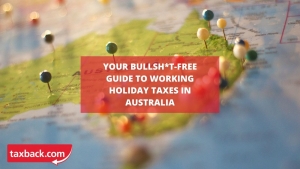A step by step guide on how to calculate your tax refund in Australia
When tax-filing season rolls around, many backpackers get a pleasant surprise when they receive their Australian tax return.
They may be due tax back simply because they paid too much income tax during the year, or they were entitled to claim certain deductions on their tax return.
But how can you calculate your tax refund?
In this guide, we'll share everything you need to know about tax, deductions, your tax return, estimating your tax refund and can you claim tax refund online.
We help thousands of working holidaymakers to get their tax refund
Table of contents:
What is a tax refund and why does it exist?
If you pay too much tax during the year, you may be entitled to some of it back. This is known as a tax refund. There are many reasons why you may be due Australian tax back. To claim your refund, you must first file a tax return. Learn more here

Did I pay too much tax? How can I calculate my tax refund? Can I claim tax refund online?
There are three main ways to calculate how much tax back you're due.
- The first is to lodge your tax return. Once your paperwork is processed, you'll then be informed by the ATO whether you have paid too much tax during the year.
- Alternatively, if you would like to know in advance of lodging your taxes, you can always run the numbers for yourself!
In order to do so you will need to know:
- How much you earned during the tax year
- Whether you're entitled to the tax-free allowance
- Your rate of Australian income tax
- Your entitlement to Australian tax deductions
Once you know these details, you will be able to compare what you should have paid in tax to what you did pay.
- Finally, if you'd like some help from Australian tax experts use the tax refund calculator and let us help you.
How much did I earn and how can I work out my total income for the year?
The basic formula you need to know is:
Taxable income = income earnings – deductibles
Your PAYG Form or final payslip will detail all of the income you earned during the tax year.
These documents also detail all of the income tax deducted.
When calculating your total income, you will also need to factor in any income you earned from investments, rent or dividends. This income is also taxable.
And, if you earn tips or commissions through your employment, you must include these for your tax reclaim in Australia.

What deductions can I include on my tax return to get more refund?
There are a number of common tax deductions which can be claimed to enhance your tax refund. These include:
- Work-related expenses
This can include vehicle and travel expenses, uniform and dry cleaning costs, tools and equipment, cell phone costs, food (if you work overtime) and self-education bills.
- Donations and charitable gifts
You may be entitled to a donation tax refund if you contributed to good causes.
- Personal superannuation contributions
- Union membership
- Investment income deductions such as interest charges and other costs
If you intend to claim any deductions on your tax return, remember to keep all relevant documents safe. This includes invoices and receipts etc.
Want to Learn More About Australian Tax?
DOWNLOAD YOUR FREE TAX GUIDE HERE
What is the low and middle-income tax offset? Can I claim it?
The low and middle-income tax offset can reduce your income tax liability.
It is available for the 2021–22, 2022–23, 2023–24 and 2024–25 tax years and can be claimed if you are an Australian resident for tax purposes.
How do I know if I have paid too much Australian income tax?
Australian tax rates are progressive. This means the more you earn the more tax you will have to pay.
That said, the exact amount of income tax that will be deducted from your pay will depend on your residency status.
Working Holidaymakers who are considered non-residents pay tax at the below rates.
Working Holidaymaker tax rates 2024-25
| Income | Tax rate |
| 0 – $45,000 | 15% |
| $45,001 – $135,000 | $6,750 plus 30 cents for each $1 over $45,000 |
| $135,001 – $190,000 | $33,750 plus 37 cents for each $1 over $135,000 |
| $190,001 and over |
$54,100 plus 45 cents for each $1 over $190,000 |
However, if you are considered a resident for tax purposes, you will be entitled to avail of the $18,200 tax-free allowance and you will be due to pay tax at the below rates.
| Income | Tax rate |
| 0 – $18,200 | Nil |
| $18,201 – $45,000 | 16 cents for each $1 over $18,200 |
| $45,001 – $135,000 | $4,288 plus 30 cents for each $1 over $45,000 |
| $135,001 – $190,000 | $31,288 plus 37 cents for each $1 over $135,000 |
| $190,001 and over | $51,638 plus 45 cents for each $1 over $190,000 |
*Medicare levy is not included in income tax rates above
How much tax refund (return) will I get?
To answer how much will you get back in taxes you must remember that it very much depends on your personal circumstances.
After all, not every backpacker in Australia is treated the same for tax purposes.
You will potentially be due tax back if:
- You are a 417 or 462 visa-holder (these are the visas typically held by backpackers)
- You are considered a resident of Australia for tax purposes for at least part of the year
- You originally come from one of the countries - United Kingdom, Chile, Finland, Germany, Japan, Israel, Norway and Turkey:
And...
You paid too much income tax during the year or you're entitled to claim tax deductions when you lodge your return.
So in order to find out how much taxes you are going to get back, use the estimator, put in your personal details and find out now.
We help thousands of working holidaymakers to get their tax refund
Tax refund case studies
Originally from Germany, Manuel visits Australia on a backpacker visa. During his time down under he travels around the country, living in many different locations and working in numerous jobs. During the year, he earns a total of $30,000 and pays a total of $4,500 in income tax. Is he entitled to a tax refund?
In order to be entitled to a tax refund, Manuel must be considered a resident for tax purposes.
Residency is determined by a number of factors such as how long you've been in the country and your behaviour while you're in Australia.
As Manuel has moved around the country and not established connections with any one location in Australia, he can't be considered as a resident for tax purposes.
Therefore, he is not entitled to claim the tax-free allowance or any deductions on his tax return.
Manuel is due to pay tax at 15% on all of his income. This comes to a total of $4,500. He is therefore not entitled to a tax refund.
Jane arrives in Australia from the UK on a backpacker visa. When she first arrives down under, Jane is considered a non-resident for tax purposes. However, Jane found a job in Brisbane and worked here for seven months. She rented an apartment in the city and established connections with the local community. Given all these factors, it's likely that Jane will be considered a resident for tax purposes. Jane earns $40,000 during the tax year and pays $6,000 in income tax. Is she entitled to a tax refund?
$6000 is equal to 15% of her $40,000. However, as a tax resident of Australia, Jane is entitled to benefit from the tax-free allowance. This means she does not have to pay tax on the first $18,200 of her income.
Her income tax bill should therefore be $3,270 (40,000 – 18,200 = 21,800. 21,800 % 100 x 15 = 3,270). She should therefore be entitled to a tax refund of $2,730. If Jane is entitled to any tax deductions – such as for work related expenses, charity contributions, union memberships etc – she may be entitled to enhance her refund further.
We help thousands of working holidaymakers to get their tax refund
I have two jobs. Will this affect my tax refund? How can I calculate my taxes?
No. You can still claim a tax refund if you have worked multiple jobs.
Make sure to keep your payslips from every employer safe as you will need them when you lodge your taxes.

When can I estimate my refund? When can I claim my tax back?
The Australian tax year ends on 31 June. The best time to estimate your refund is when the tax year ends. This way you can take your total earnings into account.
The Australian tax filing deadline is 31 October. However, you don't need to wait until the deadline to file your tax return and get your refund. You can lodge your taxes after the 1 July each year.
Learn more about the Australian tax deadline here
Can I claim a tax refund for previous years?
Wondering how much Australian tax back you're due for 2024, 2023, 2022 or prior years? Can I claim tax refund online?
If you have worked in Australia previously but did not file your tax return, the good news is that you could go back many years to claim your tax back.
In other words, if you are due tax relief for 2024, 2023, 2022, 2021 or prior years, there is still time to claim your money back.
Who can help me claim my Australian tax back?
Easy! Taxback can help you to claim your Australian tax refund easily online.
You can start by getting a free tax refund estimation of what you are owed here.
How our Australian tax refund calculator works
Our online tax refund estimator is free to use. It will quickly provide you with an accurate approximation of the refund you can expect to claim through your tax return.
To complete the calculator, you will need to know:
- The tax year you wish to apply for
- Your Visa Type
- Your total income
- How much tax you paid (you can find this information on your PAYG Form or final payslip)
- Your contact details
Then, if you're happy with what you see, you can proceed and claim your tax back!
We help thousands of working holidaymakers to get their tax refund
Why claim tax back with Taxback?
- No refund, no fee service
- Easy online application – no complicated paperwork
- Your maximum refund guaranteed – we'll transfer your refund straight to your bank account anywhere in the world
- 24/7 Live Chat support




